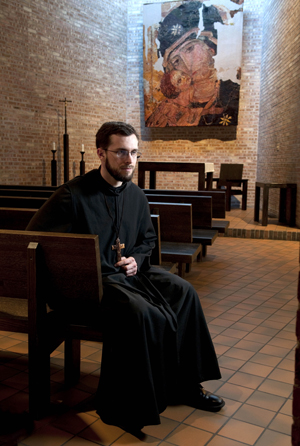Prayer leader
Austin Murphy, the youngest member of his Benedictine monastery, leads his elders as abbot.
By Jason Kelly
Photography by Lloyd DeGrane

Murphy pursued monasticism after feeling he was “being called to this place.”
A low ceiling looms over St. Procopius Abbey’s foyer, imposing darkness. “Like a tomb,” says Abbot Austin Murphy, AB’95. Intended for an Easter procession, the compressed, brick-lined hallway inside the heavy wooden doors gradually opens until it reaches a 65-foot peak in the abbey church. “A sense of expanding or rising,” Murphy says.
North light slanting from the high windows illuminates the room, the largest of several sacred spaces tucked into nooks of the Benedictine monastery in the suburban Chicago city of Lisle. The monks’ ordered days—from 6 a.m. lauds before breakfast through 7 p.m. vespers after dinner—are built around prayer.
Murphy first experienced life at this monastery during a retreat 15 years ago. He joined that week. At 36, he remains the community’s youngest member, and since June 2010, he has also been its abbot. He has an economics degree from the University—where he was known as Gregory Murphy before taking the name Austin at the monastery, in honor of St. Augustine. But his 28 fellow monks, who chose the new abbot after two days of deliberations, saw more in Murphy than an educational background suited to the administrative tasks of overseeing the abbey’s finances and property.
Father Becket Franks led the selection process. He says Murphy’s simple acts of generosity—helping older monks carry their meal trays or welcoming guests in the lobby—reflect the “servant leader” quality required of an abbot: “Someone who would stand next to somebody and say, ‘I’ll walk with you. I’ll help you along.’”
In a community where two-thirds of the monks are over age 70, Murphy also has the energy and expertise for the “race to begin attracting younger people to the abbey,” says Franks. One way Murphy reaches out is through his Facebook page, where he posts his weekly sermons, his monthly addresses to the monastic community, news items, and quotations from the Rule of St. Benedict, a book of principles that order monastic life around peace, work, and prayer. “He’s very social-media minded,” Franks says, “but he’s also very traditional.”
Raised Catholic in suburban New York City, Murphy arrived at Chicago in 1992 without a firm sense of religious direction, just an inclination to look deeper into his faith. He spent time at Calvert House, learning from chaplain Willard Jabusch, and he attended mass occasionally at St. Thomas the Apostle. Introspective by nature, he came to what he calls a “conversion” as an undergraduate.
Murphy struggles to explain in concrete terms what compelled him to pursue a religious vocation or even his spiritual experience. “In our modern world, we like to have some method, criteria to check all these things,” Murphy says, but the reality is more ambiguous. He borrows from 19th-century British Cardinal John Henry Newman. Newman, he says, compared human thought to mountain climbing—a skill that requires intensive training but is subtle and intuitive in practice, reaching here and stepping there in order to ascend. “There’s a lot of interior struggle, dialogue, so to speak, that’s hard to describe,” Murphy says. “Talking to God, praying to God, and ultimately saying yes.”
Yet after graduating in December 1995, he didn’t know what step to take next. A friend, whose father worked as a cook at St. Procopius, gave Murphy’s name to the vocation director, who invited him to a 1996 winter retreat. On the second day of the weeklong gathering Murphy told him that he did not plan to join the monastery. But by the fourth day, something about the experience—stepping back from the daily bustle, praying, and chanting psalms with the community—had changed his mind. “I had the feeling I was being called to this place. It had this kind of uneasy”—he pauses to find the right word—“persistence.”
Persistence defines the life Murphy chose. It took four years from his decision to enter the monastery until his final vows in August 2000, the standard period of immersion in the community and study of its tenets. After yet another four years, now with a master’s of divinity from the Dominican House of Studies in Washington, he was ordained a priest, an additional responsibility that not all monks pursue.
And for the past four years, Murphy has been a doctoral student at the University of Notre Dame. His dissertation—on St. Augustine’s thought regarding the inspiration of the Bible—remains to be completed. He sets aside Thursday mornings to work on it, but jokes that the demands of being abbot might make him “just another ABD.”
All the monks have assignments: some work at nearby Benedictine University or Benet Academy, others assist at Catholic parishes or serve as chaplains for religious communities, a few tend to the monastery’s grounds and facilities. Above all, Murphy says, their primary focus is the “practice of virtues.”
The practice is rooted in centuries-old Benedictine traditions. The monks gather three times a day to pray and spend additional time in individual meditation, creating what Franks describes as “the profound silence” that characterizes the abbey.
Murphy’s greatest responsibility is to foster that atmosphere, to act as the servant leader his fellow monks selected him to be. “Love of God and neighbor sums it up,” he says, a lifelong effort intended to guide them from darkness into the light, as if rising from a tomb. “The end is the kingdom of heaven, and the goal we’re busy about is purity of heart.”
